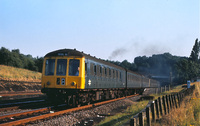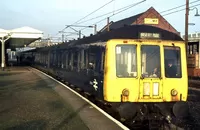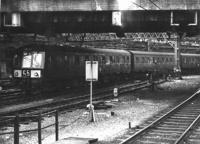Class 125 Derby 3-car DMUs
Operations
Lea Valley Line
Delivered new to Stratford depot, the sets were built for services along the Lea Valley line from London Liverpool Street into Hertfordshire and Essex, serving the lines to Cheshunt, Epping and even as far east as Southminster on the Burnham-on-Crouch branch.
The first set (E51154 + E59449 + E50988) was on show in Liverpool Street on 12 January 1959.[1]
They entered service on 19 January 1959, operating two services each way to Hertford East from Stratford and Liverpool Street. This increased from the 2nd February with an odd Bishops Stortford service. They also worked a through train to Hertford E & Buntingford for a time, departing Liverpool St about 4.20pm, dividing at St Margarets.

The image shows a set in Liverpool Street with the 3.20pm to Cheshunt, 21/1/61. Michael Mensing.
This colour video clip on youtube contains a section at 1 minute 50 seconds of a new set in use.
The large Rolls Royce 8-cylinder engines allowed them the same performance as the EMUs with which they interworked between Hertford East/Bishops Stortford and Cheshunt where the electric services went off along the re-opened Southbury line. It was also very useful on the climb from Liverpool St. to Bethnal Green.
They would also work Romford - Upminster and Southminster - Wickford services.

A Romford - Upminster service with Motor Brake Second E51156 leading in the bay platform at Romford on 11 April 1964. John Cosford.

A set stabled at Broxbourne (between Cheshunt and Roydon on the West Anglia main line). Graham Clark.
GN Lines

Two sets depart from Hadley Wood heading for Potters Bar on 7 August 1969. The closest vehicle has oval buffers, normally the type had round buffers. George Woods.
When the Lea Valley line was electrified the sets were transferred to Finsbury Park depot, most moving in 1969 and the last handful in 1970.
From there they worked on peak-hour services out of Broad Street and Kings Cross alongside loco-hauled sets and the odd Cravens (the off-peak service was entirely Cravens to the end).
On Saturdays there were just two GN services into Broad Street - the 07:55 from Hertford North and the 08:22 from Hatfield. These remained in the station until forming the 12:24 to Welwyn Garden City and 12:04 to Hertford North respectively, whereas the weekday morning arrivals would go empty to the sidings.[2]
Only one vehicle had an early withdrawal, DMBS 51170 was withdrawn from Finsbury Park in May 1971 with collision damage, details of the incdent are unknown.

A set was used to operate the RCTS / Peterborough Railway Circle 'Last Train to Oundle' railtour from Peterborough North on November 4th 1972. Booked for two sets, only five vehicles were available.[3]
The image shows a Class 125 passing Dalston Junction, returning north ECS after working the 07.45 Welwyn Garden City to Broad Street on 4 November 1976. Outside of peak-hours, the only trains here would be the Broad Street to Richmond electrics, which occupied the lines in the background. Kevin Lane.
Despite their Finsbury Park allocation and GN suburban traffic use, the sets were still regularly found at Stratford depot for maintenance. A visit on 5/4/71 found four sets there, on 20/4/75 seven sets were counted[4].

A sleepy Saturday lunch-time at Broad Street on 6 July 1974; two 501s for Richmond and a 125 on a GN line working. Kevin Lane.

With the overhead electric wires already in place, two sets prepare to leave Welwyn Garden City with a stopping service to Kings Cross on 28 January 1976. Tony Watson.
These services would also be electrified in 1977, resulting in their withdrawal as non-standard and redundant. Withdrawal dates were between October 1976 and February 1977.
Disposal
Many of the class were cut up at Doncaster Works and Booth Roe Metals, Rotherham.
Some cars spent some time in storage at March. Noted there on 1st February 1978 were 25 vehicles[5]: 59458, 51166, 51000, 59454, 51163, 59468, 59467, 51169, 51004, 59459, 59449, 59461, 59463, 51161, 59466, 51160, 50994, 51006, 51155, 51001, 59465, 51173, 50995, 59457, 50991.
The following four images were taken at March by Robert White, date unknown:
The final image shows 51172 sitting in front of 59453 & 51159 at Swindon Works on the 19th January 1978. The loco is 24 052. Neil Cannon.
References
- ⋏ p53 February 1959 Railway Observer (Railway Correspondence and Travel Society)
- ⋏ Comment by Mister C on flickr image accessed 6 September 2020.
- ⋏ "Nene Valley Special / Last Train to Oundle", Six Bells Junction, accessed Feb 28 2020
- ⋏ Notes supplied by Leonard Rogers
- ⋏ Email Gerald Brown to Stuart Mackay 22 February 2024, shown in the order listed in his notebook
Summary
Description
Diagrams and Drivers Instructions
Works Photographs
Numbering
Liveries
Operations
Non-Passenger Use
Images
No Class 125 vehicles were preserved.











